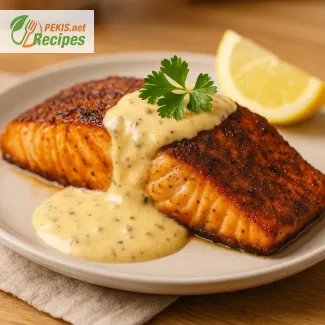
Discover the bold fusion of Cajun spice and creamy mustard in one dish
A flavor-packed salmon dish perfect for weeknights or entertaining
Few dishes strike the perfect balance between spicy, smoky, and creamy like Blackened Salmon with Creamy Dijon Sauce. This recipe takes a classic Southern blackening technique—where a bold spice rub creates a deeply charred crust—and pairs it with a silky, tangy Dijon mustard sauce that mellows the heat and elevates the overall dish to restaurant-quality elegance. Whether you're planning a quick weeknight dinner or looking for a vibrant centerpiece for a casual dinner party, this salmon recipe promises to impress with both flavor and presentation.
At the heart of this dish lies the blackened salmon itself—rich, fatty fillets seared in a hot pan to achieve a caramelized, slightly crispy crust that locks in moisture and flavor. The blackening spices, typically a mix of paprika, garlic powder, cayenne pepper, thyme, and oregano, coat the salmon and form a tantalizing golden-brown layer as they hit the sizzling heat. This technique, rooted in Cajun and Creole cooking, brings depth and complexity to the naturally buttery flavor of salmon, while giving the exterior a satisfying contrast in texture.
But what truly sets this recipe apart is the creamy Dijon sauce that’s spooned over the blackened fillets just before serving. Made with a blend of Dijon mustard, heavy cream, and a touch of lemon juice or white wine, the sauce is smooth, rich, and slightly tangy. Its creaminess gently counterbalances the spiced crust on the salmon, creating a harmonious bite that lingers on the palate. The combination of savory heat and cool creaminess is what transforms this from a simple salmon recipe into an extraordinary culinary experience.
Beyond its flavor, this dish stands out for its versatility. It pairs beautifully with a variety of side dishes—from garlic mashed potatoes, steamed green beans, and grilled asparagus, to a fresh arugula salad with vinaigrette or roasted baby carrots. For a lighter approach, serve it atop cauliflower rice, or for a bolder presentation, plate it over a bed of wild rice pilaf with toasted nuts. No matter the pairing, the blackened salmon remains the star of the show, with the Dijon cream sauce tying everything together.
Another reason this dish has gained popularity is its minimal prep time and high reward. With only a handful of pantry spices and everyday ingredients, you can create something that feels elevated without spending hours in the kitchen. The searing technique requires just a hot pan and a few minutes per side, while the sauce can be whisked together in under five minutes. It’s a dish that feels luxurious but is entirely doable on a busy evening.
What also makes this dish so appealing is its ability to suit a wide range of dietary preferences. For those who eat low-carb, the absence of breading or flour means this recipe fits beautifully into keto-friendly or paleo-inspired meal plans. For pescatarians or those simply seeking to eat more heart-healthy meals, salmon offers an excellent source of protein and omega-3s. And for home cooks who love experimenting with flavors, the spice blend can be adjusted to personal heat preferences—mild to fiery—making it endlessly customizable.
Presentation-wise, the contrast of the dark seared crust against the light creamy sauce is visually stunning. Garnishing with a few sprigs of fresh dill, a wedge of lemon, or a sprinkle of chopped chives enhances the aesthetic appeal, making it as beautiful to look at as it is to eat. It's the kind of meal that looks like it came out of a professional kitchen, but can easily be recreated at home with just a bit of confidence and the right technique.
In recent years, dishes like blackened salmon have surged in popularity due to the growing demand for meals that are both healthy and packed with flavor. The rise of interest in Cajun cuisine and the accessibility of global spice blends have made it easier than ever to bring restaurant-level flavors into everyday home cooking. Coupled with the rise of home meal presentation culture and food photography, it's no surprise that dishes featuring rich contrasts—like this one—resonate with modern food lovers across the world.
What elevates this particular recipe beyond others in the same category is the creamy Dijon sauce, a nod to French culinary tradition. Dijon mustard, known for its sharp, complex profile, enhances both the flavor and mouthfeel of the sauce, offering a gourmet touch to a relatively simple meal. The balance between earthy spice and mellow richness makes this a dish you'll want to make on repeat, and one that guests will likely ask you to share the recipe for.
Whether you’re new to blackened fish recipes or looking for a new way to cook salmon fillets, this is a foolproof recipe that offers maximum flavor with minimal effort. With every bite, you get the crunch of seared spice, the tender juiciness of perfectly cooked salmon, and the velvety coating of Dijon cream—all coming together in perfect harmony. It's bold, it's creamy, it's spicy, and it’s exactly the kind of dish that earns its place in your regular meal rotation.
- Prepare the spice mix: In a small bowl, combine paprika, garlic powder, onion powder, dried oregano, dried thyme, cayenne pepper, salt, and black pepper. Mix well.
- Season the salmon: Pat the salmon fillets dry with a paper towel. Rub both sides of each fillet generously with the spice blend, pressing it into the surface.
- Sear the salmon: Heat olive oil in a large skillet over medium-high heat. When the oil is hot but not smoking, carefully place the salmon fillets skin-side down. Cook for about 4–5 minutes per side or until a dark crust forms and the fish is cooked through. Remove and set aside.
- Make the creamy Dijon sauce: In the same pan, reduce the heat to medium and add butter. Once melted, add chopped shallots and cook for 2–3 minutes until soft. Stir in minced garlic and sauté for 30 seconds.
- Finish the sauce: Add Dijon mustard and lemon juice, then pour in the heavy cream. Whisk the sauce until smooth. Simmer gently for 3–4 minutes, seasoning with salt and pepper to taste.
- Plate the dish: Place each salmon fillet on a serving plate and spoon the creamy Dijon sauce generously over the top. Garnish with fresh herbs like parsley or dill if desired.
Elevate Your Salmon Game with Creative Ingredient Twists
Smart upgrades and flavor enhancements for blackened salmon with Dijon sauce
In the world of quick yet gourmet-style dinners, blackened salmon with creamy Dijon sauce stands out for its bold seasoning and rich, velvety finish. Yet even a well-loved classic can benefit from thoughtful refinements. Whether you're aiming to make the dish more vibrant, healthier, or personalized to your taste, there are numerous ways to improve this traditional recipe without losing the core appeal of its smoky, spicy essence paired with a creamy tang.
Experimenting with spice blends
The hallmark of blackened salmon is its spice crust, which adds depth and contrast to the buttery fish. While the traditional blend includes paprika, garlic powder, cayenne, thyme, and oregano, there is room for personalization. Swapping smoked paprika for sweet paprika can reduce heat and add a subtle sweetness. For those who enjoy Mediterranean profiles, adding ground cumin, sumac, or even dried rosemary can introduce a refreshing, earthy twist.
If you’re sensitive to heat, you can reduce or replace cayenne pepper with Aleppo pepper or mild chili flakes, which offer warmth without overpowering the palate. Alternatively, for spice lovers, a dash of chipotle powder or crushed red pepper boosts both heat and smokiness, creating a deeper flavor dimension.
Enhancing the creamy Dijon sauce
The Dijon cream sauce is where rich comfort meets culinary finesse. Traditionally made with Dijon mustard, cream, lemon juice, and shallots, it can be improved or tailored for different dietary needs or flavor profiles. For a lighter version, substitute heavy cream with Greek yogurt or crème fraîche, which maintain a smooth texture while lowering the fat content.
Adding a touch of white wine or vermouth during the sautéing of shallots introduces acidity and aromatic complexity. To make the sauce more herbaceous, stir in chopped fresh tarragon, dill, or parsley just before serving. Each herb complements the mustardy tang and brings freshness to the creamy base.
For a luxurious touch, a teaspoon of truffle oil or a pinch of grated horseradish can elevate the sauce into a fine dining experience. These additions provide an elegant contrast to the salmon's spice and round out the dish's overall flavor.
Using premium quality salmon
Another fundamental way to elevate the recipe is by selecting high-quality salmon. Opt for wild-caught salmon when possible, such as sockeye or king salmon, which tend to have a firmer texture and richer flavor compared to farm-raised varieties. Freshness is key: look for fillets with bright, moist flesh and no fishy odor.
You can also try steelhead trout as a substitute, which offers similar richness and responds well to blackening techniques. If sustainability is a priority, research local options or consult seafood sustainability guides to make informed choices.
Why homemade beats store-bought every time
Preparing this dish at home not only allows for customization, but also ensures better ingredient quality, flavor balance, and nutritional transparency. Many store-bought or restaurant versions are overloaded with sodium, processed ingredients, or contain preservatives.
Cooking at home gives you complete control over the salt level, the type of oil used, and the cooking temperature, all of which significantly affect the final outcome. Homemade versions can be made fresher, lighter, and better suited to your health and taste preferences.
Avoiding common mistakes
One of the biggest mistakes with this dish is overcooking the salmon. Blackening requires high heat, but it’s easy to go too far and dry out the fillets. Aim for medium doneness, with a flaky texture but still moist and slightly translucent in the center. Use a thermometer if needed; 52–55°C (125–130°F) is ideal for medium.
Another frequent misstep is applying the spices too early, causing them to burn before the fish is cooked. Always apply the rub just before placing the fillet in the pan, and avoid overcrowding to allow proper searing.
When making the sauce, resist boiling the cream. High heat can cause it to curdle or separate. Keep the sauce on a gentle simmer and whisk continuously to maintain its smooth texture.
Healthier adaptations without sacrificing taste
For those seeking lighter or allergen-free versions, there are many ways to adapt the recipe without compromising on flavor. Replace butter in the sauce with olive oil or plant-based margarine. Use cashew cream or coconut cream for a dairy-free alternative to heavy cream.
If you're reducing fat, consider baking or grilling the salmon instead of pan-frying it, and use a non-stick pan to minimize oil use. You can also serve the salmon with a fresh herb vinaigrette in place of the creamy sauce for a lighter but still flavorful finish.
Creative plating and side pairings
To elevate presentation and add nutritional value, pair the salmon with vibrant sides. Roasted vegetables, like carrots, fennel, or zucchini, add texture and color contrast. For starches, consider wild rice, quinoa, or sweet potato mash. A side of arugula salad with a mustard vinaigrette complements the Dijon theme while providing a peppery counterbalance.
Incorporating pickled elements, such as pickled red onions or capers, can add brightness and acidity that balance the richness of the dish. A few drops of balsamic reduction on the plate or a smear of beet purée can add a gourmet touch and visual elegance.
Make it your signature dish
Ultimately, the best way to improve any traditional recipe is by making it your own. This dish offers endless room for flavor experimentation, healthful swaps, and artful presentation. By understanding the key elements—crispy blackened crust, buttery tender salmon, and tangy Dijon cream—you can build layers of flavor that cater to any occasion or preference. Whether served on a weeknight or showcased at a dinner party, this version of blackened salmon with creamy Dijon sauce can easily become a signature in your culinary repertoire.
Allergens present:
- Dairy (butter, cream)
- Fish (salmon)
- Mustard (Dijon mustard)
Gluten: This recipe is gluten-free as written.
Suggestions for allergen and gluten replacement:
- For dairy-free: Replace butter with vegan margarine and use plant-based cream (such as oat or soy cream).
- For mustard allergy: Use a mild horseradish sauce or tahini with lemon juice for tanginess.
- For fish allergy: Substitute with grilled tofu or tempeh, seasoned with the same blackening spices.
- Vitamin D: 17 µg (85% DV) – Supports immune system and bone health.
- Vitamin B12: 3.5 µg (145% DV) – Essential for nerve function and red blood cell formation.
- Selenium: 45 µg (82% DV) – Powerful antioxidant function and thyroid support.
- Potassium: 550 mg (12% DV) – Maintains normal blood pressure and heart function.
- Phosphorus: 300 mg (43% DV) – Important for bone health and energy metabolism.
- Astaxanthin: 1.5 mg – Found in salmon, protects cells from oxidative damage, supports skin and eye health.
- Quercetin (from onions and shallots): 6 mg – Anti-inflammatory, supports cardiovascular health.
- Allicin (from garlic): 4 mg – Antimicrobial properties, supports immune function.





